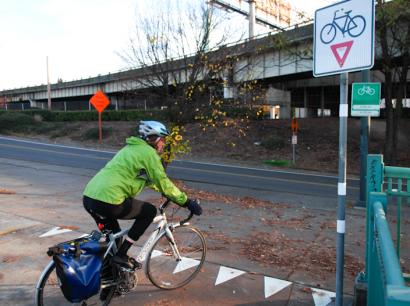
(Photos © J. Maus)
The City of Portland has installed the first of three new “yield” markings they hope will help mitigate potential bike-on-bike collisions
Roger Geller in the Office of Transportation told BikePortland this morning that he has identified three locations that he calls “potential hazard areas”. Markings at one of the locations — on the bikeway above the Eastbank Esplanade just south of the bike signal at NE Lloyd Blvd. and NE Oregon St — have already been installed.
The markings are a series of triangles that point in the direction of traffic that is required to yield. A traffic sign with a bike symbol and the red, yield triangle accompany the markings.
Geller said he focused on locations where “there needed to be some level of control to manage bike traffic.” At the NE Lloyd and Oregon St. location, bike traffic coming off the Eastbank Esplanade and heading east toward NE Lloyd enter a sidewalk/bikeway where high-speed bike traffic is coming from the north and the south.
“That corner’s a little bit blind,” said Geller, “so we wanted to let cyclists coming off the Esplanade know they should look left, then right before proceeding.”
Two other locations are slated for the markings: the sidewalk/bikeway adjacent to Union Station that takes bikes from Broadway eastbound onto the Broadway Bridge; and on the sidewalk/bikeway that leads bikes up from the Waterfront eastbound onto the Hawthorne Bridge.
In both of the above locations, bikes traveling on the sidewalk/bikeway must yield to oncoming bike traffic that is headed east from the roadway up to the bikeway.
These markings are standard in the Manual of Uniform Traffic Control Devices, but they aren’t usually used on bikeways. Geller says they reflect his continued effort to work with the traffic engineers to place more markings on the pavement, instead of just adding more signage (which is the more typical approach).


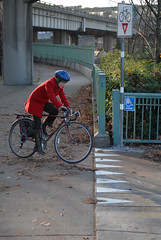
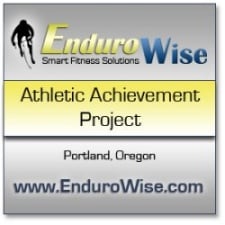

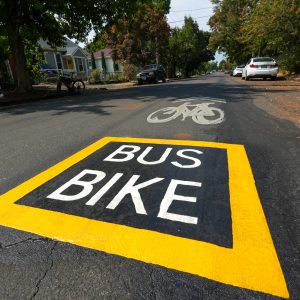
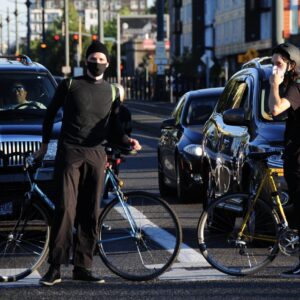
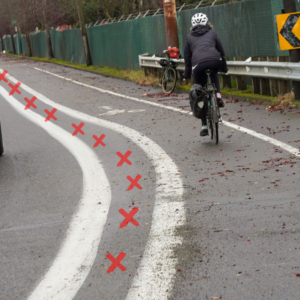
Thanks for reading.
BikePortland has served this community with independent community journalism since 2005. We rely on subscriptions from readers like you to survive. Your financial support is vital in keeping this valuable resource alive and well.
Please subscribe today to strengthen and expand our work.
I like it. As more people cycle, there will be a lot more potential for bike on bike wrecks. These markings create a very nice designation that the cyclist is leaving one path and entering another, which should have a very positive impact on people assuming that they don’t need to watch for cyclists going straight. Very well done.
I agree with you Kevin.
I think these markings show a level of respect from the city for bike traffic that is usually reserved for car traffic.
This is great. I always take that section slow because of the potential wreckage. This will quickly change all cyclists behavior at this location, from all angles. Roger rules!
Not a bad idea. The one pictured is part of my commute.
I noticed that sign on my ride to work today and I actually experienced a bike on bike collision at that exchange. While the sign is a positive step, is there any word about whether something will be done about the hedges?
That corner is a big blind spot In my opinion. I’m not sure if that is City-owned or Union Pacific-owned, but trimming and creating some visability would go much further in cutting down on the risk of a collision.
I like these more subtle cues over dotting the landscape with yet more signage. Without reading about it, I immediately understood what the markings meant and what I should do.
Yes this is a great first step…this is a very common use of this type of marking for bikeways in the Netherlands, etc. I take this route a lot going to from Vancouver USA.
Though from the photo perspective…I was wondering why the whole width of the level pathway was marked yield…if ‘we’ are employing the more typical layout should not the ‘sharks teeth’ symbols only reached 1/2 way across the rightaside of the path with a short center line dash? (This would attempt to communicate to bike traffic how to approach this trail intersection with two way bike traffic.)
And also…any consideration given to a high contrast marking/ RPMs of the steps that start there? (So novice trail rider know not to clip the corner too fast in the dark.)
I think these are great….BUT what about just trimming the darn hedge so I can see over it?
Trim the hedges!
Also, a convex safety mirror would let cyclists coming up the ramp see cross traffic before entering the intersection.
I’m glad they aren’t bike-sized stop sign happy. Those yield pavement markings look pretty sweet when you think about them. Seriously though, just trim the hedges already.
“This will quickly change all cyclists behavior at this location”
Seems a little excessive to me. I’ve always wondered exactly how the heck the city expects people to know what all of their various bike themed markings mean. At this point you’ve got these yield things, the green boxes, the “sharrows” and whatever else is going on. Perhaps they should put up, oh I don’t know, a yield sign like people are used to seeing. Making up some brand new symbol for every new occasion doesn’t make any sense, especially if it is supposed to be geared toward the general public. The intention is good but the execution is silly.
dentron 3000:
I can appreciate your confusion. The idea here is that the roadway provides us with perhaps the best canvas for communicating expectations of behavior. Cyclists (and motorists) generally look at the pavement more than they look at signs. This seems especially true in urban environments where there are lots of other things competing for a person’s attention. That’s why we feature the markings on the pavement. The installation at this location does include a yield sign, as well.
Keep in mind that we didn’t make these markings up. The yield marks are standard traffic control devices as identified in the federal Manual of Uniform Traffic Control Devices (MUTCD), and have been since at least 2003. Look at page 3B-26 of this documentM.
We try to make our designs as intuitive as possible. We’re encouraged by a study in San Francisco that showed that sharrows are effective at creating more space between cyclists and parked cars, as well as between motorists passing cyclists, than in their absence. These shared lane markings are also going to be included as a standard in the above-mentioned traffic manual. We’ve also been encouraged by the green bike boxes, which most people seemed to understand immediately. We’re doing a thorough study of their effectiveness, as well.
Of course, not everybody’s going to get it right away, just like not everybody’s going to see a sign right away…
Thanks for the feedback.
I saw these same markings recently on a freeway onramp